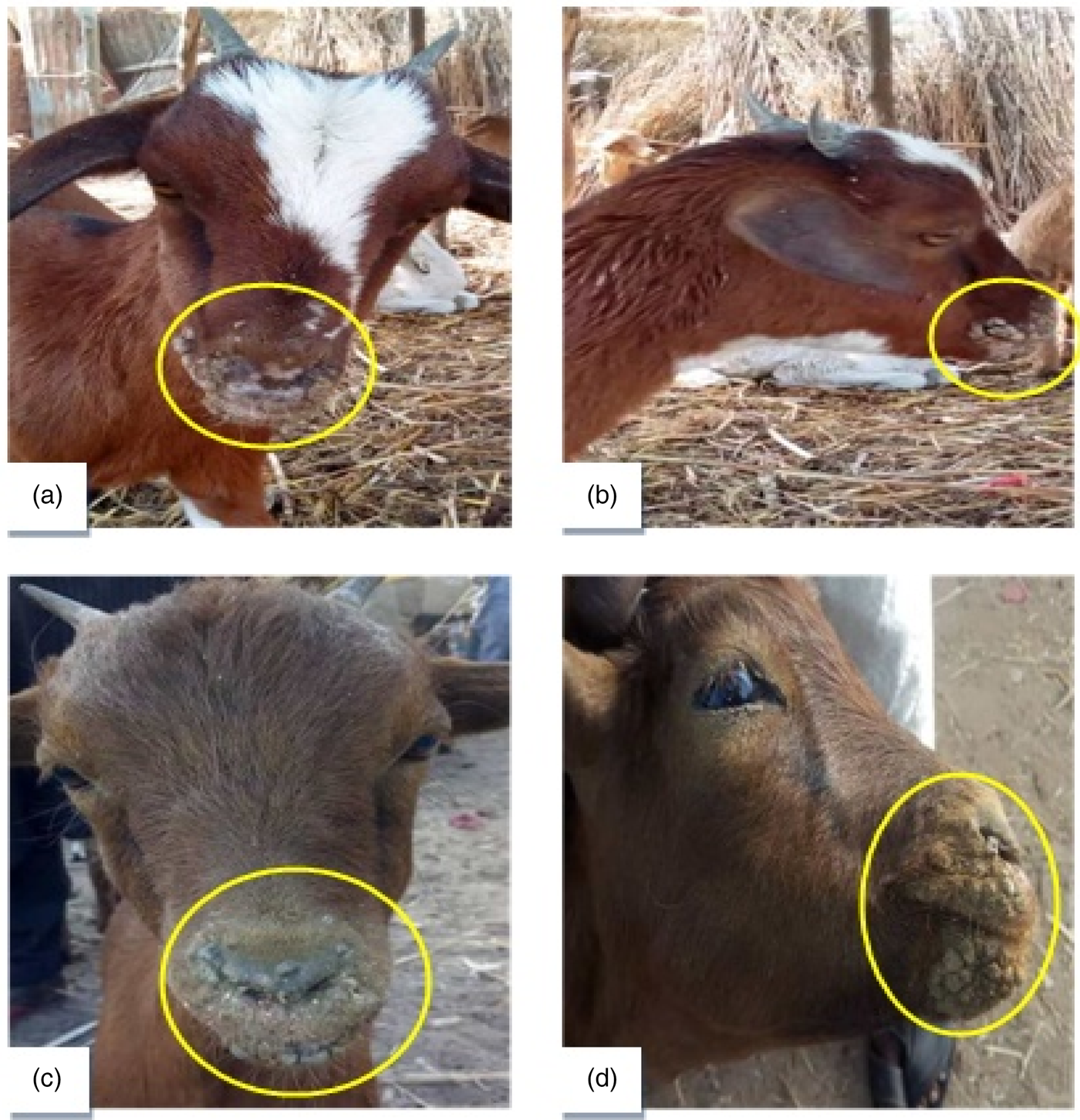Contagious Pustular Dermatitis
Syn: Contagious ecthyma, scabby mouth, sore mouth, Orf
- It is highly contagious viral disease of goat and sheep characterized by development of pustular and scabby lesion on muzzle and lips.
- Such eruptions like papules or vesicles of pox like lesion can be seen on cornea, nostril and eyes, vulva, udder and teats of sheep;
- Lesions are proliferative and lead to formation of scabs.

Etiology
- Parapox virus of Poxviridae family
- It is distinct from vaccinia virus but has antigenic similarity to goat pox virus but not with sheep pox virus.
- Virus withstand drying and survives at room temperature for at least 15 years.
- Virus particles are 270 x 160 µm in size
Epidemiology
- Disease is found globally in sheep and goat populations.
- Young animals, especially lambs and kids are more susceptible to severe form of disease.
- Outbreaks can occur more frequently during late summer, fall and winter or when animal are housed in feedlots.
- Morbidity of disease is usually high ~ 90% whereas mortality is around 15% but may reach 75%.
- The higher mortality was observed among flocks with mixed infections of orf and Peste des petits (PPR) or Orf and Hemonchosis as compared to other outbreaks.
- The Orf outbreaks were reported across various Indian states, viz., Uttarakhand, Assam, Meghalaya, Haryana, Uttar Pradesh, Rajasthan, Tripura, Kashmir, Tamil Nadu, and Odisha.
Transmission
- Disease may be transmitted through skin abrasion and contact with infected animals or contaminated fomites.
- Scab falling to ground during healing acts as source of infection.
- Direct contact between infected and healthy individual.
- Inhalation of droplets contaminated with viral particles.
Pathogenesis
- Virus gains entry through skin abrasion or direct contact with fomites or animals
- Virus invades epithelial cells of nostrils and commissure of lips and replicates there.
- Replication of virus leads to development of characteristic skin lesion. First papules, then progress to vesicles, pustules.
- Finally, pustules ruptures and form scabs that eventually dries off and fall off.
Clinical Signs
- IP= 2-3 days in sheep and goat
- Dullness, depression, anorexia and rise of temperature varying from 106-108°F.
- Profuse salivation, lacrimation accompanied with mucopurulent discharge
- Congestion of nasal and buccal mucosa with appearance of nodular eruptions on oral commissure, lips, mouth and nostril.
- Lesion develop initially as papules and then rapidly progresses to pustules and scabs.
- Scab forms within 1 week and peel off the skin within 4 weeks.
- more severely affected lambs do not eat normally, and they lose condition.

PM Findings
- Typical ulcerative lesion in nasal cavities and URT
- Erosion on mucosa of esophagus, abomasum and small intestine
- Lymph nodes congested and dark red in color
- Lesion appears on mucocutaneous junction of the lips and around erupting incisor teeth, and it may extend to the mucosa of the buccal cavity.
- Occasionally, lesions are found on the feet and around the coronet, where secondary bacterial infection with Dermatophilus congolensis commonly leads to strawberry footrot.
- Ewes nursing infected lambs may develop lesions on the teats that extend onto the udder skin.

Diagnosis
- On the basis of clinical findings
- On the basis of PM findings
- Serological test: CFT, AGDT, FAT
- Animal inoculation test: Vesicular fluids or suspension of scab materials may be swabbed into scarified skin of known immune and non-immune animals. They may be observed for the appearance of characteristics lesion.
Differential Diagnosis
- Blue tongue:
- Severe systemic reaction
- Lesion occur on muzzle and coronet
- Ulcerative dermatosis:
- It causes tissue dermatitis and ulcer
- It affects older animals.

Treatment and Control Measures:
- Application of 5% CuSO4 after removal of scab (7% iodine or 3% phenol)
- Unattenuated live virus vaccine; age: 4-6 weeks, by scarification at hairless or wool less areas, Booster: 2-3 months later.
- Both parenteral and topical antimicrobials may help combat secondary bacterial infection of the skin lesions of contagious ecthyma.
- In endemic areas, appropriate repellents and larvicides should be applied to the lesions to prevent myiasis.
- Veterinarians and sheep handlers should exercise reasonable protective precautions and wear disposable gloves.
- vaccinated animals should be segregated from unprotected stock until the scabs have fallen off.